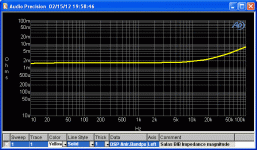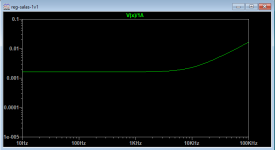Hi Salas, thank you for your excellent regulator.
What is the lowest CCS recommended for this design?
Can you cascade 2 regulators. For example, I require both +35V and +15V. Could you feed the output of the +35V to a circuit as well as a +15V salas regulator (probably via a small voltage dropping resistor) to feed a different part of the circuit that requires 15V?
I don't wish to use more than transformer or use an expensive custom transformer with different taps.
Any help here is very much appreciated.
What is the lowest CCS recommended for this design?
Can you cascade 2 regulators. For example, I require both +35V and +15V. Could you feed the output of the +35V to a circuit as well as a +15V salas regulator (probably via a small voltage dropping resistor) to feed a different part of the circuit that requires 15V?
I don't wish to use more than transformer or use an expensive custom transformer with different taps.
Any help here is very much appreciated.
Lowest CCS +50mA over the load's peak current demand. But it can work down to the CC limit before the output voltage drops.
Better +100mA. Hot-Rod +200mA.
Theoretically they could be cascaded but personally I haven't used two units in that way to can tell you if there could be any odd side effects like oscillations. Just arrange them like that and check if their outputs behave well before deciding to install them.
Better +100mA. Hot-Rod +200mA.
Theoretically they could be cascaded but personally I haven't used two units in that way to can tell you if there could be any odd side effects like oscillations. Just arrange them like that and check if their outputs behave well before deciding to install them.
Thanks again Salas for your speedy reply. When you say " Better +100mA. Hot-Rod +200mA" what are you meaning? Better regulation, lower output impedance, lower noise etc?
If I do find an oscillation, can a capacitor be use to remove the oscillation and where would I place it in the circuit? Also is it possible to still buy 2SK117?
If I do find an oscillation, can a capacitor be use to remove the oscillation and where would I place it in the circuit? Also is it possible to still buy 2SK117?
Lower output impedance & lower intermodulation distortion on the rails when with a strongly varying load.
Put the extra cap at the load or at the output connector. But first try two wire mode. You can alternatively buy surface mount 2SK880-GR and use SOT23 to DIP adapter mini boards so to try keep away from 2SK117 Ebay fakes. 2SK880 Toshiba JFET | Mouser
Put the extra cap at the load or at the output connector. But first try two wire mode. You can alternatively buy surface mount 2SK880-GR and use SOT23 to DIP adapter mini boards so to try keep away from 2SK117 Ebay fakes. 2SK880 Toshiba JFET | Mouser
Not easy to reliably measure a PSU's noise out of the common mode and RF noise that creep in a bench setup. It takes high price differential analyzer lab gear. When at 5mV/div on the scope, even lower if it can, from power off PSU to power on PSU the line's noise on the screen should barely change if at all from what random noise baseline the whole test loop with leads and the scope itself can achieve best. Set the horizontal to somewhat fast enough sweep time like 50uS. No distinct AC waveform must appear (high frequency oscillation) just a straight line with the least amount of hash you can manage in your bench test.
Luckily Jack Walton (member JackinNJ here) had done well organized extensive tests on several PSU designs using his Audio Precision station. Some of those including the SSLV1.1 were part of an article in Linear Audio Vol. 4 and they used to be accessible as pictures.
I can still find only a couple of those charts in our forum to link. The nV/RtHz Y axis indicator wasn't there on the original second chart as far as I can remember. 10-6 should be 1uV/rtHz and 10-9 should be 1nVrt/Hz I believe. See about square root Hz noise: datasheet - Noise and what does V/√Hz actually mean? - Electrical Engineering Stack Exchange
There was an output impedance chart also that verified my simulation's prediction surprisingly well. But I can't find a link for it anymore.

I can still find only a couple of those charts in our forum to link. The nV/RtHz Y axis indicator wasn't there on the original second chart as far as I can remember. 10-6 should be 1uV/rtHz and 10-9 should be 1nVrt/Hz I believe. See about square root Hz noise: datasheet - Noise and what does V/√Hz actually mean? - Electrical Engineering Stack Exchange
There was an output impedance chart also that verified my simulation's prediction surprisingly well. But I can't find a link for it anymore.

An externally hosted image should be here but it was not working when we last tested it.
I was looking at these graphs just the other day - here is the link to them on the Linear audio website:
Downloads | Linear Audio
Many thanks to Mssrs. Walton and Didden for making the data available.
Downloads | Linear Audio
Many thanks to Mssrs. Walton and Didden for making the data available.
Yep those are the ones, thanks a lot.
Additionally I found in my archives an older, for the BiB only, Zo graph that Jack once posted in the simplistic low voltage regulators thread.
Also here's my simulated Zo graph when the regulator's settings should have been the same as in his test. Resulting in same spare current.
Practically very close results. Except for one detail. The predicted curve has a quicker supersonic rise to 16mΩ 100kHz while Jack's measured curve has a slower rise to 8mΩ 100kHz. Spice models can sometimes be little pessimistic for intrinsic capacitance of some actual production parts to our benefit it seems
Additionally I found in my archives an older, for the BiB only, Zo graph that Jack once posted in the simplistic low voltage regulators thread.
Also here's my simulated Zo graph when the regulator's settings should have been the same as in his test. Resulting in same spare current.
Practically very close results. Except for one detail. The predicted curve has a quicker supersonic rise to 16mΩ 100kHz while Jack's measured curve has a slower rise to 8mΩ 100kHz. Spice models can sometimes be little pessimistic for intrinsic capacitance of some actual production parts to our benefit it seems
Attachments
Hi,
I would like to use SSLV as a power supply to my BeagleBoneBlack board (BBB) 5V DC.
The challenge is charging process of the BBB battery. During normal work BBB consume about 0,4A but during charging max current usage is about 1,2A.
Max current consumption is during boot and charging for a first 5-10minutes. After that is gradually drop to typical 0,4A.
I thought that I could try SSLV. I need fix it at CCS= 1,5A.
Please advise which parts to use that regulator could withstand 5V DC and 1,5A load.
Could I use C104=10uF/400V foil capacitor?(A capacitor that has remained unused from another project). What capacitor do you recommend in the C102 position for Vout=5V DC/1.5A?
Thanks in advance,
Bern
I would like to use SSLV as a power supply to my BeagleBoneBlack board (BBB) 5V DC.
The challenge is charging process of the BBB battery. During normal work BBB consume about 0,4A but during charging max current usage is about 1,2A.
Max current consumption is during boot and charging for a first 5-10minutes. After that is gradually drop to typical 0,4A.
I thought that I could try SSLV. I need fix it at CCS= 1,5A.
Please advise which parts to use that regulator could withstand 5V DC and 1,5A load.
Could I use C104=10uF/400V foil capacitor?(A capacitor that has remained unused from another project). What capacitor do you recommend in the C102 position for Vout=5V DC/1.5A?
Thanks in advance,
Bern
Hi,
I would like to use SSLV as a power supply to my BeagleBoneBlack board (BBB) 5V DC.
The challenge is charging process of the BBB battery. During normal work BBB consume about 0,4A but during charging max current usage is about 1,2A.
Max current consumption is during boot and charging for a first 5-10minutes. After that is gradually drop to typical 0,4A.
I thought that I could try SSLV. I need fix it at CCS= 1,5A.
Please advise which parts to use that regulator could withstand 5V DC and 1,5A load.
Could I use C104=10uF/400V foil capacitor?(A capacitor that has remained unused from another project). What capacitor do you recommend in the C102 position for Vout=5V DC/1.5A?
Thanks in advance,
Bern
There will be much wasted heat during BBB's average loading. Shunts are better suited to high consumption steady draw loads like Class A linear. You should use IRF9530 for both Mosfets if you insist. Set to 1.3A CCS since 1.2A loading will be rare.
Maybe you could use a high efficiency switching state cheap little psu like those on eBay and a turn over switch for changing to the shunt after the boot period? You could keep the faster 9610 CCS Mosfet and set at just 0.6A that way. Unless there are still rare and sudden current draw bursts after boot which if current limited the CPU will freeze or the BBB will just reset.
Yes you can use your 10uF foil as C104. C102 470uF 25V Low Z type.
Thank you Salas......Maybe you could use a high efficiency switching state cheap little psu like those on eBay and a turn over switch for changing to the shunt after the boot period? ....
Very good idea to split battery charging and 'normal' BBB load
Quick research shows me that I could use:
LIPO battery charger and
Very small 46x25x21mm 5V/1A power supply for a charger
Since after the power split the BBB's CCS would be below 1A so I could use Ref-D instead of SSLV
Regards,
Bern
For BBB the Reflektor-D is better adapted. Use two wire output mode if to switch between efficient and shunt so to be safer against RFI since there will be change over extension circuitry. Better a relay near the load with a panel switch energizing it to reduce cable length.
I use LIPO battery to allow Linux to clean poweroff BBB after the main switch off.For BBB the Reflektor-D is better adapted. Use two wire output mode if to switch between efficient and shunt so to be safer against RFI since there will be change over extension circuitry. Better a relay near the load with a panel switch energizing it to reduce cable length.
The switching of power sources (battery or power supply from mains) is done automatically by the BBB hardware and Linux. One thing I should do (wanting to have a separate battery charging power supply apart from having a separate battery charger) is to remove jumper on the board responsible for 'internal' charging.
After that my BBB consume 320-410mA and I can use Ref-D with R1=1 ohm (or 2x2ohm/2W in parallel).
Can I use somehow my spare 10uF foil capacitors in the ref-D build?
Regards,
B
I found these on Ebay. Is there any way know if these are actual Toshiba devices or if they are counterfeit?
LOT of 10 TOSHIBA 2SK117-GR , Transistor JFET Low Noise , N-CH Si 3-Pin, TO-92 | eBay
LOT of 10 TOSHIBA 2SK117-GR , Transistor JFET Low Noise , N-CH Si 3-Pin, TO-92 | eBay
Could you make a draw?
I have no drawing, was just a quick idea. Maybe when I will find time.
- Home
- Amplifiers
- Power Supplies
- SSLV1.1 builds & fairy tales

